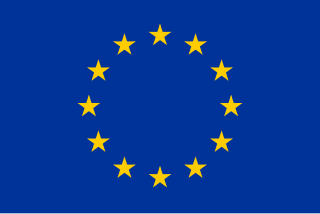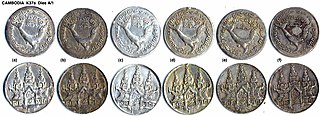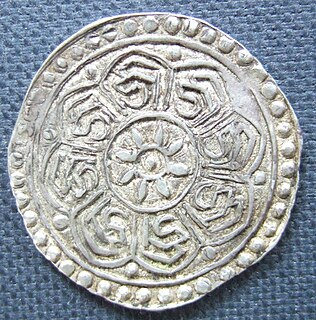 W
WOn 8 November 2016, the Government of India announced the demonetisation of all ₹500 and ₹1,000 banknotes of the Mahatma Gandhi Series. It also announced the issuance of new ₹500 and ₹2,000 banknotes in exchange for the demonetised banknotes. Prime Minister Narendra Modi claimed that the action would curtail the shadow economy and reduce the use of illicit and counterfeit cash to fund illegal activity and terrorism.
 W
WThe Aachen penny of Charlemagne, a Carolingian silver coin, was found on 22 February 2008 in the foundations of the Palatine Chapel in Aachen, during archaeological work in the northeastern bay of the hexadecagon. This is the first discovery of coinage from the time of Charlemagne at Aachen.
 W
WAxe-monies refer to bronze artifacts found in both western Mesoamerica and the northern Andes. Based on ethnohistorical, archaeological, chemical, and metallurgical analyses, the scholars Hosler, Lechtman and Holm have argued for their use in both regions through trade. In contrast to naipes, bow-tie- or card-shaped metal objects which appear in the archaeological record only in the northern Andean coastal region, axe-monies are found in both Mesoamerican and Andean cultural zones. More specifically, it is argued that the system of money first arose on the north coast of Peru and Ecuador in the early second millennium CE. In both regions, bronze was smelted, likely by family units, and hammered into thin, axe-shaped forms and bundled in multiples of five, usually twenty. As they are often found in burials, it is likely that in addition to their presumed economic use, they also had ceremonial value.
 W
WBitcoin is a cryptocurrency, a digital asset designed to work as a medium of exchange that uses cryptography to control its creation and management, rather than relying on central authorities. The history of bitcoin started with the invention and was implemented by the presumed pseudonymous Satoshi Nakamoto, who integrated many existing ideas from the cypherpunk community. Over the course of bitcoin's history, it has undergone rapid growth to become a significant currency both on- and offline. From the mid 2010s, some businesses began accepting bitcoin in addition to traditional currencies.
 W
WCanada has an extensive history with regard to its currencies. Prior to European contact, indigenous peoples in Canada used items such as wampum and furs for trading purposes, which continued when trade with Europeans began.
 W
WCard money is a type of fiat money printed on plain cardboard or playing cards, which was used at times as currency in several colonies and countries from the 17th century to the early 19th century. Where introduced, it was often followed by high rates of inflation.
 W
WThe history of coins extends from ancient times to the present, and is related to economic history and the history of mint. Coins are still widely used for monetary and other purposes.
 W
WThe euro came into existence on 1 January 1999, although it had been a goal of the European Union (EU) and its predecessors since the 1960s. After tough negotiations, particularly due to opposition from the United Kingdom, the Maastricht Treaty entered into force in 1993 with the goal of creating an economic and monetary union by 1999 for all EU states except the UK and Denmark.
 W
WThe Gesellschaft für Internationale Geldgeschichte is a non-profit organisation incorporated in Frankfurt am Main in Germany, dedicated to scientific research in history of money and medal science.
 W
WA gold rush or gold fever is a discovery of gold—sometimes accompanied by other precious metals and rare-earth minerals—that brings an onrush of miners seeking their fortune. Major gold rushes took place in the 19th century in Australia, New Zealand, Brazil, Canada, South Africa, and the United States, while smaller gold rushes took place elsewhere.
 W
WThe currency of Indonesia, the rupiah, has a long history that stretches back to colonial period. Due to periods of uncertain economy and high inflation, the currency has been re-valued several times.
 W
WMuseum Reksa Artha is a history museum located in Jakarta, Indonesia.
 W
WThe tenge is the currency of Kazakhstan. It is divided into 100 tiyn. The ISO-4217 code is KZT.
 W
WThe tenga was the currency of Kokand until 1876. Silver tenga circulated with copper pul and gold tilla. There was no fixed relationship between the three denominations. The Russian ruble replaced the Pul, Tenga and Tilla.
 W
WThe history of the Rupee traces back to ancient Indian subcontinent. The mention of rūpya by Panini is seemingly the earliest reference in a text about coins. The term in Indian subcontinent was used for referring to a coin.
 W
WThe history of Cambodian and Thai money, Tical or Pod Duang used as a medium of exchange and to settle accounts before the reformation of Thai baht coins and banknotes include novel designs and forms. For Thai people, money was considered as the symbol of civilization. Currency itself reflected faith in religion, culture, the customs and traditions of each era and also serve as a record of the development of Thailand.
 W
WThe use of historical money in Tibet started in ancient times, when Tibet had no coined currency of its own. Bartering was common, gold was a medium of exchange, and shell money and stone beads were used for very small purchases. A few coins from other countries were also occasionally in use.
 W
WThe tangka was a currency of Tibet until 1941. It was subdivided into 15 skar or 1½ sho and, from 1909, it circulated alongside the srang, worth 10 sho.
 W
WThe withdrawal of a country's lowest-denomination coins from circulation may either be through a decision to remove the coins from circulation, or simply through ceasing minting.